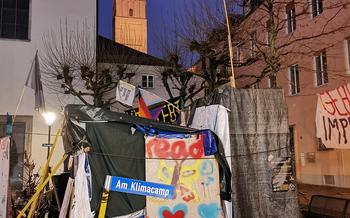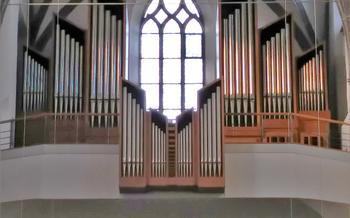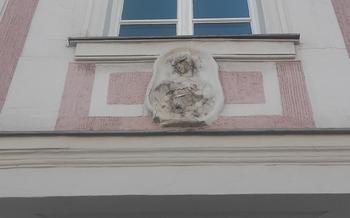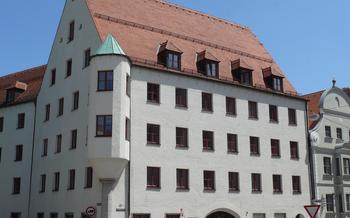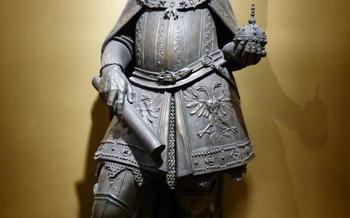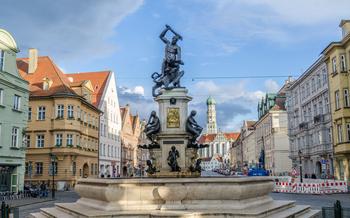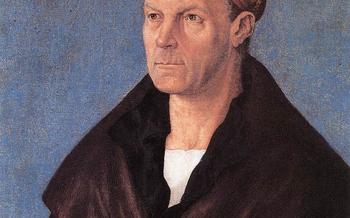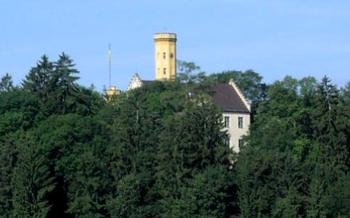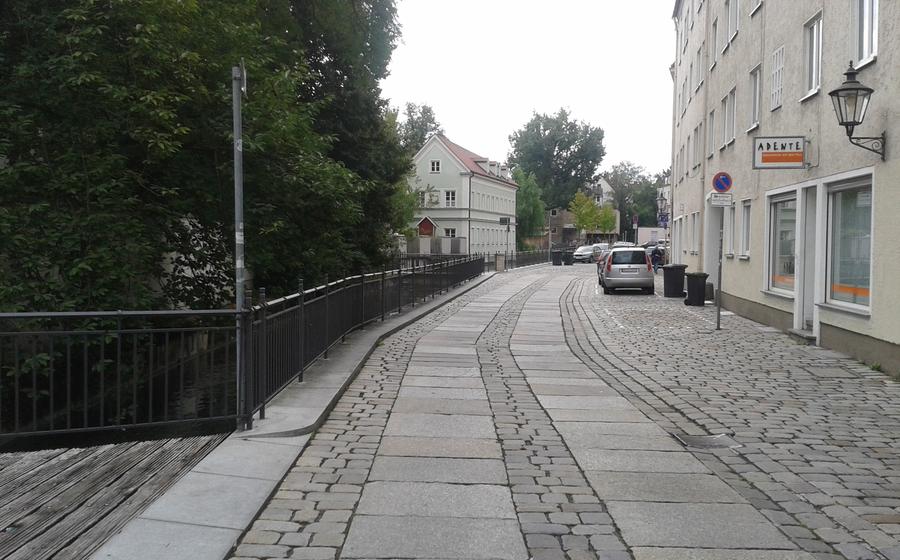
Lechviertel
- The People's Theater
- St. Ulrich's Church: A Gothic Revival Masterpiece
- The Town Hall: A Symbol of Renaissance Splendor
- The Maximilian Museum: A Treasure Trove of History and Culture
- The Fuggerei: A Haven of Social Housing
- The Brecht House: A Window into the Life of a Literary Legend
- The Red Gate: A Historic Sentinel
- The Fugger Palaces
- The Zeughaus
- The Zoo Augsburg
- The Lech River and Parks: An Oasis of Tranquility Amidst the City's Bustle
- The City Market
- Insider Tip: Experience the Lechviertel's Charm
The People's Theater
The People's Theater (Volkstheater) is a cultural landmark in the Lechviertel district, symbolizing the neighborhood's rich artistic heritage. Founded in 1907, this historic venue has played a pivotal role in promoting theater and performing arts in Augsburg. The striking architectural features of the theater, designed by renowned architect Otto Bouman, showcase a captivating blend of Art Nouveau and Neoclassical styles. The theater's elegant facade, intricate detailing, and spacious interior create a unique ambiance that enhances the overall experience for theatergoers.
Over the years, the People's Theater has hosted a multitude of notable productions, from classic plays to contemporary works, featuring talented actors and actresses who have graced its stage. The theater's diverse repertoire has captivated audiences, making it a beloved cultural hub in the Lechviertel. From thought-provoking dramas to lighthearted comedies, the People's Theater offers a platform for artistic expression that resonates with the local community and visitors alike.
St. Ulrich's Church: A Gothic Revival Masterpiece
Standing tall amidst the vibrant streets of the Lechviertel, St. Ulrich's Church captivates visitors with its exquisite Gothic Revival architecture. Built in the late 15th century, this magnificent edifice showcases intricate stone carvings, soaring buttresses, and a graceful steeple that pierces the sky.
Inside, the church's grandeur continues to unfold. The nave features a series of elegant pointed arches, creating a sense of spaciousness and light. The intricate stained glass windows bathe the interior in a kaleidoscope of colors, casting a mystical glow upon the sacred space.
One of the most striking features of St. Ulrich's Church is its impressive altarpiece. Crafted in the early 16th century, this masterpiece depicts scenes from the life of Christ in intricate detail. The expressive figures and vibrant colors bring the biblical stories to life, captivating the hearts and minds of believers.
Beyond its architectural and artistic significance, St. Ulrich's Church holds a deep spiritual meaning for the people of Augsburg. Throughout the centuries, it has served as a place of worship, community, and solace. Its Gothic Revival style, with its emphasis on verticality and light, embodies the aspiration for a closer connection with the divine.
St. Ulrich's Church stands as a testament to the enduring legacy of faith and artistry in Augsburg. Its Gothic Revival splendor invites visitors to immerse themselves in the beauty of sacred architecture and experience the spiritual essence that has permeated its walls for centuries.
The Town Hall: A Symbol of Renaissance Splendor
The Town Hall of Augsburg stands as a testament to the city's rich history and architectural prowess. Built in the 17th century, this magnificent Renaissance masterpiece dominates the central Rathausplatz, captivating visitors with its intricate details and opulent grandeur. The façade is a symphony of arches, pilasters, and elaborate ornamentation, showcasing the skill and artistry of the era's finest craftsmen.
The Golden Hall, the heart of the town hall, is a breathtaking spectacle of Baroque opulence. Its walls are adorned with vibrant frescoes depicting scenes from Augsburg's history, while the intricate ceiling murals celebrate the glory of the Holy Roman Empire. The hall's centerpiece is the majestic fountain, a symbol of justice and wisdom, which presides over official ceremonies and events.
Augsburg's Town Hall is not just an architectural marvel but also a living testament to the city's vibrant cultural heritage. Throughout the centuries, it has served as the seat of local government, witnessed countless historical events, and played a pivotal role in shaping the city's identity. From the opulent banquets of the Renaissance elite to the solemn deliberations of modern-day city council meetings, the town hall's walls have echoed with the voices of power, progress, and civic pride.
As you marvel at the grandeur of the Town Hall, take a moment to reflect on the rich tapestry of history woven within its walls. It is a building that speaks of Augsburg's enduring spirit, its unwavering commitment to progress, and its deep appreciation for the arts and culture that have shaped its unique identity.
The Maximilian Museum: A Treasure Trove of History and Culture
The Maximilian Museum, located in the heart of the Lechviertel district, is a must-visit for history and culture enthusiasts. Founded in 1864, the museum houses an extensive collection of artifacts, artworks, and documents that narrate the rich history of Augsburg and the surrounding region.
The museum's exhibits are diverse and captivating, encompassing everything from prehistoric finds to medieval treasures and modern masterpieces. Highlights include the Hall of Fame, which showcases portraits of prominent figures from Augsburg's past, and the Roman Room, which features artifacts from the city's Roman origins.
The Maximilian Museum is not merely a repository of historical relics; it is also a vibrant cultural center that hosts temporary exhibitions, educational programs, and interactive displays. Visitors can engage with hands-on activities, learn about the latest research in archaeology and history, and participate in workshops and lectures.
The museum's commitment to preserving and presenting Augsburg's cultural heritage makes it a valuable resource for both locals and visitors. Whether you are interested in art, history, or simply want to delve deeper into the city's identity, the Maximilian Museum is sure to captivate and inspire.
The Fuggerei: A Haven of Social Housing
In the heart of Augsburg, nestled amidst the cobbled streets and historic buildings of the Lechviertel, lies the Fuggerei, a unique and enduring legacy of social responsibility and architectural ingenuity. Founded in 1521 by the wealthy merchant Jakob Fugger the Elder, the Fuggerei is the world's oldest continuously inhabited social housing project, offering affordable homes to those in need.
Consisting of 67 houses arranged in neat rows, the Fuggerei is a testament to the Fugger family's philanthropic spirit and their commitment to providing dignified living conditions for the less fortunate. The houses, while modest in size, are well-maintained and offer basic amenities, ensuring a comfortable and secure living environment for their residents.
Stepping into the Fuggerei is like stepping back in time. The narrow streets, lined with pastel-colored houses and adorned with intricate ironwork, exude an old-world charm that transports visitors to a bygone era. The communal courtyard, with its central fountain and lush greenery, provides a serene and inviting space for residents to gather and socialize.
Intriguing stories and legends surround the Fuggerei, adding to its mystique and allure. It is said that Jakob Fugger, upon his death, left a secret endowment to ensure the Fuggerei's continued existence and prosperity. Another legend tells of a hidden underground tunnel that connects the Fuggerei to the Fugger family's grand palace, allowing them to discreetly monitor the well-being of their tenants.
A visit to the Fuggerei is a journey through history, architecture, and social consciousness. It is a reminder of the power of compassion and the enduring impact of charitable endeavors. As you wander through its cobblestone streets and admire its well-preserved houses, you will gain a deeper appreciation for the Fugger family's legacy and the enduring spirit of community that has sustained the Fuggerei for over 500 years.
The Brecht House: A Window into the Life of a Literary Legend
Nestled amidst the cobblestone streets of the Lechviertel, the Brecht House stands as a testament to the life and work of one of Germany's most influential playwrights, Bertolt Brecht. Built in the 16th century, this unassuming yet historically significant building was once home to Brecht and his family from 1924 to 193
Inside the Brecht House, visitors can immerse themselves in the world of this literary giant. The museum's exhibits provide a glimpse into Brecht's personal life, his artistic process, and his political views. Original manuscripts, photographs, and personal belongings offer a tangible connection to the playwright's creative genius.
The Brecht House also hosts cultural events, readings, and exhibitions that explore Brecht's work and its enduring legacy. Visitors can attend thought-provoking discussions, theatrical performances, and film screenings that delve deeper into the themes and ideas that shaped Brecht's writing.
Whether you're a longtime admirer of Brecht's work or simply curious about the life of this influential figure, a visit to the Brecht House is a must. It's a chance to step back in time and experience the world through the eyes of one of the 20th century's most important literary voices.
The Red Gate: A Historic Sentinel
Amidst the bustling streets of Augsburg's Lechviertel, the Red Gate stands as a proud reminder of the city's rich history. Built in the 13th century as part of the city's medieval fortifications, this magnificent gate is one of the few remaining relics of that era. Its name derives from the distinctive red bricks used in its construction, which have weathered the passage of time to retain their vibrant hue.
The Red Gate served as a crucial defensive structure, protecting the city from invaders and ensuring the safety of its inhabitants. Its imposing tower and sturdy walls were designed to withstand attacks, and its strategic location at the entrance to the city made it a key point of defense. Over the centuries, the gate witnessed countless battles and sieges, bearing silent witness to the city's struggles and triumphs.
Today, the Red Gate stands as a symbol of Augsburg's resilience and enduring spirit. It has been meticulously restored to its former glory, and visitors can marvel at its architectural beauty and historical significance. Intricate carvings adorn the gate's facade, depicting scenes from Augsburg's past and paying homage to the city's rich cultural heritage.
As you pass through the Red Gate, you can't help but feel a sense of awe and wonder. It's a tangible connection to the past, a reminder of the city's tumultuous history and the indomitable spirit of its people. The Red Gate is not just a historical monument; it's a living testament to Augsburg's enduring legacy.
The Fugger Palaces
The Fugger family, one of the wealthiest and most influential merchant families in Europe during the Renaissance, left an indelible mark on Augsburg with their magnificent palaces. The Fuggerhäuser, built in the 16th century, are a testament to the family's opulence and power. The grandest of these palaces, the Fuggerei, is a sprawling complex that once housed over 100 members of the Fugger clan. With its intricate facades, opulent interiors, and private gardens, the Fuggerei offers a glimpse into the lavish lifestyle of the Fuggers.
Another notable palace is the Fuggerhaus am Jakoberwall, known for its stunning Renaissance architecture and impressive art collection. The palace houses a significant collection of paintings, sculptures, and tapestries, reflecting the Fuggers' passion for art and culture. Visitors can admire works by renowned artists such as Hans Holbein the Younger, Lucas Cranach the Elder, and Albrecht Dürer, offering a unique insight into the artistic patronage of the Fuggers.
The Zeughaus
The Zeughaus, or Armory, in Augsburg is a building of historical significance that once served as a storage facility for weapons and military equipment. Constructed in the 17th century, it stands as a testament to the city's rich military history and its role as a major trading hub. Today, the Zeughaus has been transformed into a museum, showcasing a fascinating collection of weapons, armor, and military artifacts that provide a glimpse into the city's past.
Visitors to the Zeughaus are treated to an array of exhibits that showcase the evolution of weaponry and military technology. From swords and shields to muskets and cannons, the museum's collection is diverse and captivating. Among the highlights are a suit of armor that once belonged to a 16th-century knight, a collection of intricately engraved firearms, and a display of medieval siege weapons.
Beyond its historical artifacts, the Zeughaus also boasts unique architectural features that add to its charm. The building's exterior is adorned with decorative elements and sculptures, while the interior features a series of vaulted ceilings and intricate archways. These architectural details, combined with the building's historical significance, create a truly immersive experience for visitors.
One of the most intriguing aspects of the Zeughaus is its collection of historical anecdotes and stories. Visitors can learn about the legendary gunsmiths of Augsburg, whose skills were renowned throughout Europe, and the role that the city played in the production and trade of weapons and ammunition. These stories bring the museum's exhibits to life and provide a deeper understanding of the city's past.
Whether you're a history buff, a weapons enthusiast, or simply someone who appreciates unique architectural landmarks, the Zeughaus is a must-visit attraction in Augsburg. Its fascinating exhibits, historical significance, and captivating stories offer a glimpse into the city's rich military heritage and its role as a major trading hub.
The Zoo Augsburg
The Zoo Augsburg is a must-visit destination for animal lovers and families seeking a fun and educational day out. Founded in 1937, the zoo is home to over 1,200 animals representing more than 250 species from around the world. Immerse yourself in the diverse habitats, from lush tropical rainforests to frozen Arctic landscapes, and encounter fascinating creatures up close.
The zoo's commitment to animal welfare and conservation is evident in its spacious enclosures, naturalistic exhibits, and ongoing research and breeding programs. Visitors can observe majestic lions, playful meerkats, graceful giraffes, and mischievous monkeys in their recreated natural environments. The aquarium section showcases a vibrant underwater world with colorful fish, elegant sea turtles, and mesmerizing jellyfish.
Beyond animal encounters, the Zoo Augsburg offers a range of educational programs, interactive exhibits, and special events throughout the year. Attend informative talks by zookeepers, participate in hands-on workshops, and witness exciting animal feeding sessions. The zoo also hosts regular events such as themed weekends, night safaris, and family-friendly festivals, ensuring a memorable experience for all ages.
Whether you're looking for a fun-filled family adventure, an educational outing, or simply a peaceful escape surrounded by wildlife, the Zoo Augsburg has something for everyone. Take a leisurely stroll through the serene grounds, admire the beauty of nature, and create lasting memories in the company of incredible animals from across the globe.
The Lech River and Parks: An Oasis of Tranquility Amidst the City's Bustle
Augsburg's Lech River, with its serene waters and picturesque banks, offers a welcome respite from the bustling city center. The riverfront is a popular destination for locals and visitors alike, providing a tranquil oasis for relaxation and rejuvenation.
Stroll along the well-maintained paths that hug the river's edge, and admire the stunning views of the city skyline, with its historic buildings and modern skyscrapers creating a harmonious blend of old and new. Take a break on one of the many benches and soak in the peaceful atmosphere, listening to the gentle lapping of the water and the chirping of birds.
For a more active experience, rent a bike and pedal along the designated bike trails that run alongside the river. The scenic route offers a unique perspective of the city and its surroundings, allowing you to explore hidden corners and picturesque spots.
If you prefer to be on the water, embark on a leisurely boat tour that will take you past some of Augsburg's most iconic landmarks, including the Lechviertel, the Red Gate, and the Fuggerhaus. Enjoy the sights from a different vantage point and learn about the city's rich history and culture from knowledgeable guides.
For those seeking adventure, try your hand at water sports such as kayaking or stand-up paddleboarding. The calm waters of the Lech River provide the perfect conditions for beginners and experienced paddlers alike. Glide along the river, surrounded by lush greenery and the tranquil sounds of nature.
Whether you're looking for a peaceful retreat, an active adventure, or a fun-filled family outing, the Lech River and its surrounding parks offer something for everyone. Escape the hustle and bustle of the city and immerse yourself in the natural beauty and serenity of this urban oasis.
The City Market
Immerse yourself in the vibrant atmosphere of the City Market, located in the heart of the Lechviertel district. This bustling marketplace has been a hub of trade and commerce for centuries, offering a diverse array of local produce, culinary delights, and traditional crafts. As you wander through the stalls, you'll be greeted by the friendly smiles of vendors eager to share their stories and the secrets behind their products.
Indulge in freshly baked pastries, artisanal cheeses, fragrant spices, and seasonal fruits and vegetables. Discover unique souvenirs, handcrafted pottery, and intricate textiles that showcase the region's rich cultural heritage. The City Market is also a culinary paradise, where you can savor traditional Bavarian dishes, sample international street food, and sip on refreshing beverages.
Beyond its commercial significance, the City Market holds historical and cultural importance. It has witnessed the ebb and flow of history, serving as a meeting point for locals and visitors alike. Join the lively crowd, soak up the vibrant atmosphere, and experience the authentic charm of this beloved market.
Insider Tip: Experience the Lechviertel's Charm
To fully immerse yourself in the charm of the Lechviertel, plan your visit during the summer months when the weather is pleasant, and the streets come alive with outdoor events. The annual Lechviertel Festival, held in July, is a highlight, showcasing local culture, music, and culinary delights. Don't miss the opportunity to explore the hidden courtyards, discover unique boutiques, and savor traditional Bavarian cuisine at one of the many charming restaurants. For a unique perspective, take a guided tour led by a local expert who can share fascinating stories and anecdotes about the district's rich history and heritage. Whether you're a history buff, an art enthusiast, or simply seeking a vibrant and authentic experience, the Lechviertel has something to offer everyone.
